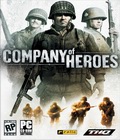
Genre : Real Time Strategy
Publisher: THQ
Developer: Relic
Release Date: 2/1/2006
I’m as sick of World War II games as the next guy, if not moreso. At this point, a game set in that period has to do something pretty special to make me sit up and take notice.
For example, it could blow everything up.
Company of Heroes is an RTS where everything explodes. You control the soldiers of Able Company as they fight across Europe, starting from D-Day and moving forward into Germany itself. The whole game is a ground war, allowing you to control infantry, jeeps, tanks, and a variety of other units.
Your strategy must take the environments into account, which are fully destructible and manipulable. You can plow through a building with tanks, shatter a storefront with anti-tank rockets, or drop explosives on open ground so your infantrymen can take cover in the resulting crater. Relic’s goal, in making the game, was to allow a player to do anything you can do on a real battlefield, from occupying a storefront to obliterating an offensive city block with artillery fire. If the battlefield, after you’re done, doesn’t look like the surface of the moon, then you did something wrong.
The game employs two different engines. One, the Essence Engine, is used to create high-quality, cinematic cutscenes that can go seamlessly into the gameplay. The other is, of course, Havok 3.0, which lets every stick, brick, and cloud of dust on the battlefield have its own physics. It’s all about the little details, including the interactivity onscreen.
You have not seen a building collapse in an RTS until you’ve seen how it goes down in Company of Heroes. It’s crazy. Each structure is made up of a variety of panels which can be damaged and destroyed individually, thus ensuring that no two buildings will take damage or explode in the same way.
That attention to detail also applies to individual soldiers. As noted above, they’re smart enough to take care of themselves, ducking behind whatever’s available, automatically taking cover when you tell them to move, and getting out of the way of incoming vehicles. Of course, the same applies to the enemy, which really cranks up the amount of things that happen onscreen at once. I came pretty close to sensory overload while watching the demo.
A single common soldier has some impressive AI, and more than two thousand animations, including ragdoll physics. The Havok engine lets each soldier and ground unit take location damage; for example, a tank that takes a rocket or two to its back end will no longer be able to move. It can still rotate its turret, but its engine’s been disabled. The same applies if a grenade gets underneath its treads.
Company of Heroes is still a long way from being complete. What I saw was a pre-alpha, but I also saw a really good-looking RTS. I’d like to see the industry move away from World War II games, yes, but I’d also like to see more games with as much realism and as many options as Company of Heroes has.
More articles about Company Of Heroes











 Company of Heroes delivers the World War II real-time strategy classic and both its expansions in one battle-hardened bundle.
Company of Heroes delivers the World War II real-time strategy classic and both its expansions in one battle-hardened bundle.












